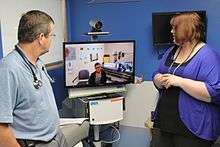Telenursing

Telenursing refers to the use of telecommunications and information technology in the provision of nursing services whenever a large physical distance exists between patient and nurse, or between any number of nurses. As a field, it is part of telehealth, and has many points of contacts with other medical and non-medical applications, such as telediagnosis, teleconsultation, telemonitoring, Telemedicine etc.
Telenursing is achieving a large rate of growth in many countries, due to several factors: the preoccupation in driving down the costs of health care, an increase in the number of aging and chronically ill population, and the increase in coverage of health care to distant, rural, small or sparsely populated regions. Among its many benefits, telenursing may help solve increasing shortages of nurses; to reduce distances and save travel time, and to keep patients out of hospital. A greater degree of job satisfaction has been registered among telenurses.[1]
Applications
Home care
One of the most distinctive telenursing applications is home care. For example, patients who are immobilized, or live in remote or difficult to reach places, citizens who have chronic ailments, such as chronic obstructive pulmonary disease, diabetes, congestive heart disease, or debilitating diseases, such as neural degenerative diseases (Parkinson's disease, Alzheimer's disease or ALS), may stay at home and be "visited" and assisted regularly by a nurse via videoconferencing, internet or videophone. Other applications of home care are the care of patients in immediate post-surgical situations, the care of wounds, ostomies or disabled individuals. In normal home health care, one nurse is able to visit up to 5-7 patients per day. Using telenursing, one nurse can “visit” 12-16 patients in the same amount of time.
Case management
A common application of telenursing is also used by call centers operated by managed care organizations, which are staffed by registered nurses who act as case managers or perform patient triage, information and counseling as a means of regulating patient access and flow and decrease the use of emergency rooms. McKesson is a leading telephone health service provider in the United States of America, as well as in Australasia.
Telephone triage
Telephone triage refers to symptom or clinically-based calls. Clinicians perform symptom assessment by asking detailed questions about the patient's illness or injury. The clinician's task is to estimate and/or rule out urgent symptoms. They may use pattern recognition and other problem-solving process as well. Clinicians may utilize guidelines, in paper or electronic format, to determine how urgent the symptoms are. Telephone triage requires clinicians to determine if the symptoms are life-threatening, emergency, urgent, acute or non-acute. It may involve educating and advising clients, and making safe, effective, and appropriate dispositions—all by telephone. Telephone triage takes place in settings as diverse as emergency rooms, ambulance services, large call centers, physician offices, clinics, student health centers and hospices.
Countries using telephone triage
An International Telenursing survey was completed in 2005, reporting that the 719 responding full time and part time Registered Nurses and Advanced Practice Nurses worked as a telenurse in 36 countries around the world. 68% of these Telenurses where reported to be working in the United States of America, whereas .6% where to be working in Finland. Some of these 36 counties include;[2]
- Australia
- Canada
- Norway
- United Kingdom
- New Zealand
- Iran
- Sweden
- Netherlands
Telenursing in Australia
In Australia, telephone triages are conducted in Western Australia, Australian Capital Territory, Northern Territory, Victoria and Queensland. The first telenursing triage was conducted in Western Australia in 1999, where Triage nurses would estimate patient complexity and refer them to Fremantle Hospital. Due to the remoteness of the Australian landscape it is vital that residents living in rural areas have access to clinical support and care. Telenursing allows nurses to overcome the barriers of distance and gives them the opportunity assist those who are unable to access health care clinics or services due to either the late hour or the distance.[3]
Legal, ethical and regulatory issues
Telenursing is fraught with legal, ethical and regulatory issues, as it happens with telehealth as a whole. In many countries, interstate and intercountry practice of telenursing is forbidden (the attending nurse must have a license both in their state/country of residence and in the state/country where the patient receiving telecare is located).[4] The Nurse Licensure Compact helps resolve some of these jurisdiction issues. Legal issues such as accountability and malpractice, etc. are also still largely unsolved and difficult to address. Ethical issues include maintaining autonomy, maintaining a patients integrity as well as preventing harm to a patient.[5]
In addition, there are many considerations related to patient confidentiality and safety of clinical data.
References
Notes
- ↑ Nurses Happier Using Telecare, Says International Survey, eHealth Insider website, 15 June 2005, retrieved 2009-04-04;
- ↑ GRADY, JANET L.; SCHLACHTA-FAIRCHILD, LORETTA. "Report of the 2004-2005 International Telenursing Survey". Computers, Informatics, Nursing. 25 (5): 266–272. doi:10.1097/01.ncn.0000289163.16122.c2.
- ↑ Karabatsos, Georgia; Wilson, Andrew (June 2008). "Universal telenursing triage in Australia and New Zealand: A new primary health service" (PDF). Australian Family Physician. 37 (6): 476–9.
- ↑ Hutcherson, Carolyn M (September 30, 2001). "Legal Considerations for Nurses Practicing in a Telehealth Setting". Online Journal of Issues in Nursing. 6 (3). Retrieved 12 May 2016.
- ↑ Hoglund, A; Holstrom, I. "Ethical Issues In Telenursing". International Hospital. Retrieved 12 May 2016.
Bibliography
- Telenursing: Nursing Practice in Cyberspace. By Charles C Sharpe, 2000. 280 pg.
- Textbook in Health Informatics: A Nursing Perspective. Edited by J. Mantas, A. Hasman, 2002. IOS Press, 504 pg.
- International Standards for Telenursing Programmes, International Council of Nurses, 2001. 40 pg.
External links
- Telehealth: Issues for Nursing. American Nursing Association.
- Telenursing Fact Sheet. International Council of Nurses.
- International Society for Telemedicine & eHealth (ISfTeH) - Telenursing Working Group